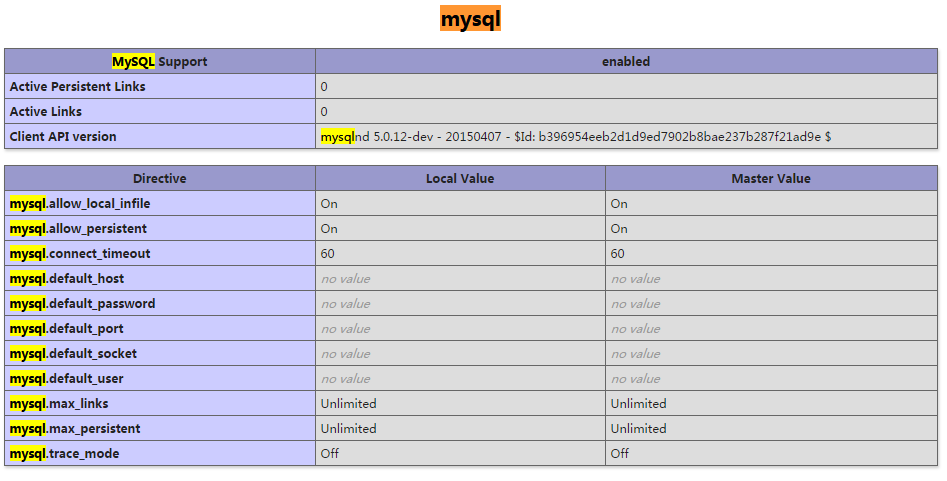 Database
Database Mysql Tutorial
Mysql Tutorial Detailed introduction on how to use rpm package to install MySQL on CentOS7
Detailed introduction on how to use rpm package to install MySQL on CentOS7Instructions
This article was written on 2017-05-20, using MySQL-5.7.18. The operating system is 64-bit CentOS Linux release 7.2.1511 (Core), installed in desktop mode.
Uninstall MariaDBCentOS7 installs MariaDB by default instead of MySQL, and MySQL-related software packages are also removed from the yum server. Because MariaDB and MySQL may conflict, uninstall MariaDB first. View the installed MariaDB related rpm packages.rpm -qa | grep mariadbCheck the installed MariaDB related yum package. The package name needs to be judged based on the result of the
rpm command.
yum list mariadb-libsRemove the installed MariaDB related yum package. The package name needs to be judged based on the result of the
yum list command. This step requires root privileges.
yum remove mariadb-libsDownload MySQL rpm packageSince the software package is very large, you can download it through other methods (such as Thunder) first. Using the rpm method, you can also install it without being able to connect to the Internet - this is something that yum cannot do. If you need to install other versions of MySQL, please go to the official website
to search for the corresponding rpm download link.
wget https://cdn.mysql.com//Downloads/MySQL-5.7/mysql-5.7.18-1.el7.x86_64.rpm-bundle.tarUse rpm package to install MySQLThe following steps require root permissions. And due to the dependencies between packages, each
rpm command must be executed in order.
mkdir mysql-5.7.18 tar -xv -f mysql-5.7.18-1.el7.x86_64.rpm-bundle.tar -C mysql-5.7.18 cd mysql-5.7.18/ rpm -ivh mysql-community-common-5.7.18-1.el7.x86_64.rpm rpm -ivh mysql-community-libs-5.7.18-1.el7.x86_64.rpm rpm -ivh mysql-community-client-5.7.18-1.el7.x86_64.rpm rpm -ivh mysql-community-server-5.7.18-1.el7.x86_64.rpmAfter successful installation, you can also
delete the installation files and temporary files.
cd .. rm -rf mysql-5.7.18 rm mysql-5.7.18-1.el7.x86_64.rpm-bundle.tarChange MySQL initial passwordThe following steps require root permissions.
- Since the password is not known at the beginning, first modify the
configuration file /etc/my.cnf
to make MySQL skip the login permissions test. Add a line:<p style="margin-bottom: 7px;">skip-grant-tables<br/></p>
- Restart MySQL.
service mysqld restart
- Log in to MySQL without a password.
mysql
- Execute the following command on the mysql client to change the root password.
use mysql; UPDATE user SET authentication_string = password('your-password') WHERE host = 'localhost' AND user = 'root'; quit;
- Modify the configuration file
/etc/my.cnf
Delete the previousAddthat lineskip-grant-tables, and restart MySQL. This step is very important, failure to perform it may lead to serioussecurity issues. - Log in using the password you just set.
mysql -u root -p
- MySQL will force you to change the password, and it cannot be a simple rule password.
ALTER USER root@localhost IDENTIFIED BY 'your-new-password';
The above is the detailed content of Detailed introduction on how to use rpm package to install MySQL on CentOS7. For more information, please follow other related articles on the PHP Chinese website!
 CentOS7怎么安装Mysql并设置开机自启动Jun 02, 2023 pm 08:36 PM
CentOS7怎么安装Mysql并设置开机自启动Jun 02, 2023 pm 08:36 PMcentos7不带mysql数据库了,默认的数据库是mariadb(mysql的一个分支)。可以按照以下步骤手动安装mysql数据库。1.下载rpm安装文件wgethttp://repo.mysql.com/mysql-community-release-el7.rpm2.执行rpm安装rpm-ivhmysql-community-release-el7.rpm依赖解析完成后,出现下列选项:dependenciesresolved=================================
 centos7怎么查看php安装目录?三种方法分享Mar 22, 2023 am 10:38 AM
centos7怎么查看php安装目录?三种方法分享Mar 22, 2023 am 10:38 AM如果你正在使用 CentOS 7 操作系统,需要查看 PHP 安装目录以便定位配置文件、扩展等相关信息,那么就需要了解一些相关命令和技巧。下面,我们将为您介绍一些方法来查看 CentOS 7 上的 PHP 安装目录。
 CentOS7如何安装Nginx并配置自动启动May 14, 2023 pm 03:01 PM
CentOS7如何安装Nginx并配置自动启动May 14, 2023 pm 03:01 PM1、官网下载安装包选择适合linux的版本,这里选择最新的版本,下载到本地后上传到服务器或者centos下直接wget命令下载。切换到/usr/local目录,下载软件包#cd/usr/local#wgethttp://nginx.org/download/nginx-1.11.5.tar.gz2、安装nginx先执行以下命令,安装nginx依赖库,如果缺少依赖库,可能会安装失败,具体可以参考文章后面的错误提示信息。#yuminstallgcc-c++#yuminstallpcre#yumins
 怎么在CentOS7中使用Nginx和PHP7-FPM安装NextcloudMay 24, 2023 pm 08:13 PM
怎么在CentOS7中使用Nginx和PHP7-FPM安装NextcloudMay 24, 2023 pm 08:13 PM先决条件64位的centos7服务器的root权限步骤1-在centos7中安装nginx和php7-fpm在开始安装nginx和php7-fpm之前,我们还学要先添加epel包的仓库源。使用如下命令:yum-yinstallepel-release现在开始从epel仓库来安装nginx:yum-yinstallnginx然后我们还需要为php7-fpm添加另外一个仓库。互联网中有很个远程仓库提供了php7系列包,我在这里使用的是webtatic。添加php7-fpmwebtatic仓库:rpm
 CentOS7下怎么部署php7.1和开启MySQL扩展May 28, 2023 pm 03:01 PM
CentOS7下怎么部署php7.1和开启MySQL扩展May 28, 2023 pm 03:01 PM简单安装(yum方式)安装软件源添加epel源[root@opstrip.comopt]#rpm--import/etc/pki/rpm-gpg/rpm-gpg-key*[root@opstrip.comopt]#rpm-uvhhttp://mirrors.rit.edu/fedora/epel//7/x86_64/e/epel-release-7-9.noarch.rpm添加remi源[root@opstrip.comopt]#rpm-uvhhttp://rpms.remirepo.net/e
 如何在 CentOS 7 中安装并配置 Java 环境变量?Apr 22, 2023 pm 04:28 PM
如何在 CentOS 7 中安装并配置 Java 环境变量?Apr 22, 2023 pm 04:28 PM安装环境:Centos764位Jdk1.864位Xshell免费版win10*64位一、先进来,你需要检查自己的openjdk是否卸载(或者判断是否存在,因为一般centos都会预装openjdk):在xshell或rpm-qa|grepjdk中输入rpm-qa|grepjavarpm-qa|grepjava第二,如果有一个对应的openjdk,并且显示了一个响应列表,那么就需要卸载它。在xshell中输入rpm-e-nodepstzdata-文件名(这个文件名是你查看的openjdk文件列表中
 Centos7改系统时区方法有哪些Mar 03, 2023 am 10:47 AM
Centos7改系统时区方法有哪些Mar 03, 2023 am 10:47 AMCentos7修改系统时区的两种方法:1、使用timedatectl命令,可设定和修改时区信息,语法“timedatectl set-timezone 时区标识”;2、修改用户目录下的“.bash_profile”文件,在文件末尾追加“TZ='时区标识'; export TZ”即可。
 centos7使用rpm安装mysql5.7的方法May 27, 2023 am 08:05 AM
centos7使用rpm安装mysql5.7的方法May 27, 2023 am 08:05 AM1.下载4个rpm包mysql-community-client-5.7.26-1.el7.x86_64.rpmmysql-community-common-5.7.26-1.el7.x86_64.rpmmysql-community-libs-5.7.26-1.el7.x86_64.rpmmysql-community-server-5.7.26-1.el7.x86_64.rpm想要用迅雷进行下载得先找到对应的rpm下载路径首先浏览器打开mysql官网:在打开的界面,按键盘f12打开开发者工具


Hot AI Tools

Undresser.AI Undress
AI-powered app for creating realistic nude photos

AI Clothes Remover
Online AI tool for removing clothes from photos.

Undress AI Tool
Undress images for free

Clothoff.io
AI clothes remover

AI Hentai Generator
Generate AI Hentai for free.

Hot Article

Hot Tools

WebStorm Mac version
Useful JavaScript development tools

DVWA
Damn Vulnerable Web App (DVWA) is a PHP/MySQL web application that is very vulnerable. Its main goals are to be an aid for security professionals to test their skills and tools in a legal environment, to help web developers better understand the process of securing web applications, and to help teachers/students teach/learn in a classroom environment Web application security. The goal of DVWA is to practice some of the most common web vulnerabilities through a simple and straightforward interface, with varying degrees of difficulty. Please note that this software

Zend Studio 13.0.1
Powerful PHP integrated development environment

Dreamweaver Mac version
Visual web development tools

Notepad++7.3.1
Easy-to-use and free code editor






